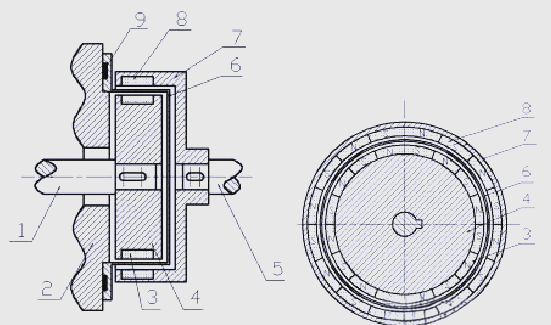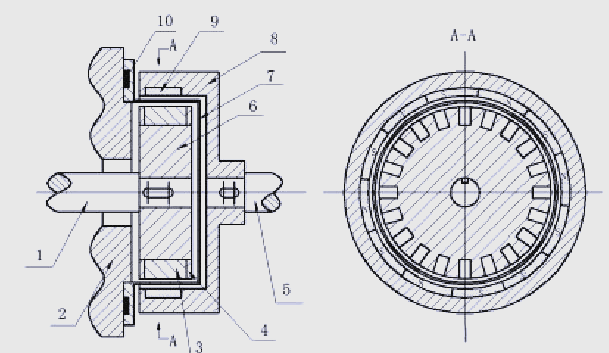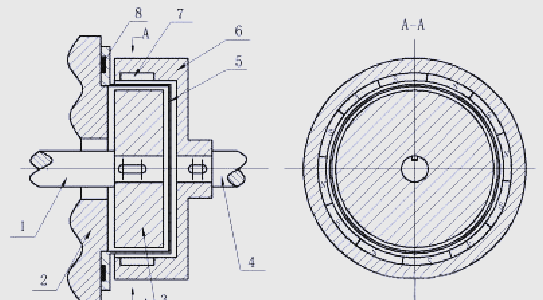Exploring Magnetic Couplings: Technological Innovation and Application Field Analysis
2025-03-19 13:13
Analysis of magnetic coupling technology and application fields
introduction
In the transmission process of mechanical power system, coupling, as a key component, plays an indispensable role. The magnetic coupling, as a special type of coupling, was originally developed to deal with the leakage problem in the conveying process. Through the ingenious structural design, the dynamic seal of the shaft and the body is transformed into the static seal of the isolation sleeve and the body, so as to achieve an effective solution to the leakage problem. The main composition of the magnetic coupling is to use the isolation sleeve to tightly enclose the inner rotor and the driven parts inside the body, and through magnetic coupling, the motion form and power of the driving parts are efficiently transmitted to the driven parts without mechanical contact. Because of this, magnetic couplings have been widely used and promoted in many industries such as petroleum, chemical, papermaking, electroplating, etc.
1. Overview of the research and development of magnetic couplings
The magnetic coupling, an innovative design born to solve the problem of leakage in the conveying process, began its extraordinary journey since HMD developed the world's first magnetic pump in 1946. Subsequently, this technology was adopted and further developed by ICI in the UK. A few years later, the former West Germany also succeeded in developing a magnetic coupling, which was widely used by Bayer Chemie. So far, the research on magnetic pumps in foreign countries has been quite mature, and its design trend is moving towards complexity, miniaturization, standardization, serialization and large-scale. In order to further improve the performance of magnetic pumps, it is particularly important to study the performance of magnetic couplings. At present, the magnetic couplings that have been studied more at home and abroad can be divided into two categories: synchronous and asynchronous according to the working principle, and can be divided into cylindrical and flat disc according to the structure.
1.1 Overview of the research and development of synchronous cylindrical magnetic couplings
The structure of the synchronous cylindrical magnetic coupling is shown in Figure 1, and the circumference of the inner and outer rotors are distributed with small permanent magnets of the same size, and these permanent magnets are arranged in the circumferential direction of alternating north and south. The magnetic coupling works on the principle of same-sex repulsion and opposite-sex attraction between magnetic poles. When the motor drives the outer rotor to rotate, an angle is generated between the permanent magnet on the outer rotor and the permanent magnet of the inner rotor, which then produces a push-pull magnetic force to drive the inner rotor to rotate. This magnetic coupling not only has a high output torque, stable operation and excellent efficiency, but more importantly, it eliminates the need for shaft seals, thus completely solving the leakage problem, making it ideal for hazardous applications. At present, the research of synchronous cylindrical magnetic coupling has been quite mature, and has been productized, has been widely used, and there are many domestic enterprises engaged in the production of synchronous magnetic coupling.

Figure 1 illustrates the structure of a synchronous cylindrical magnetic coupling. Small permanent magnets of the same size are arranged equally apart from the circumference of the inner and outer rotors, and these permanent magnets are arranged in a circumferential direction according to the rule of alternating north and south. The magnetic coupling works on the principle of same-sex repulsion and opposite-sex attraction between magnetic poles. When the motor drives the outer rotor to start rotating, an angle will be created between the permanent magnets on the outer rotor and the permanent magnets of the inner rotor, which will trigger a push-pull magnetic force, which in turn will drive the inner rotor to rotate with it. This magnetic coupling not only features high output torque, stable operation and high performance, but also eliminates the need for shaft seals, completely eliminating the potential leakage problem and enabling its use in hazardous areas. At present, the research of synchronous cylindrical magnetic coupling has been quite mature, and has been productized, widely used in many fields, at the same time, many domestic enterprises have also joined the production of synchronous magnetic coupling.
1. Input shaft 2. Airframe 3. Internal Magnet 4. Internal Rotor 5. Output shaft 6. Isolation Sleeve 7. External rotor 8. Outer Magnet 9. Seals
1.2 Research progress of asynchronous flat disc magnetic coupling
Asynchronous flat disc magnetic coupling, as a kind of eddy flow type magnetic coupling, has attracted much attention since 1995 when it was developed by Oregon National University and other institutions in the United States with its unique flat disc structure magnet elements and the transverse arrangement of the main and driven disks. This coupling is mainly used for the connection between the motor and the load, and is widely used in the production field with its high transmission efficiency. At present, the research mainly focuses on the use of layer analysis theory to explore the magnetic field, torque and transmission performance, and optimize the design. In recent years, the research of adjustable speed asynchronous flat disc magnetic coupling has been particularly active, developed rapidly, and remarkable results have been achieved. Well-known domestic universities such as Jilin University have also joined the research ranks, and a variety of research types such as fixed air gap, delayed and torque limited have emerged.
1.3 Research and development of asynchronous cylindrical magnetic couplings
As the core component of magnetic couplings, the material selection of permanent magnets is crucial. Iron neodymium materials are widely used due to their unique physical properties, but they also face the challenge of high-temperature demagnetization. In a high-temperature environment, this type of permanent magnet not only loses some of its magnetic properties, but also affects the performance and life of the magnetic coupling. In order to overcome this limitation and broaden the application range of magnetic couplings, the Xu Shifen Research Institute of Jiangsu University has conducted in-depth research. Based on the principle of electromagnetic induction, they have innovatively developed a variety of high-temperature resistant asynchronous cylindrical magnetic couplings, which are unique in that only permanent magnets are arranged on the outer rotor. This design not only effectively isolates the direct contact between the high-temperature medium and the permanent magnet, but also slows down the diffusion of the medium temperature by selecting an isolation sleeve made of non-conductor material, thereby significantly reducing the influence of the high-temperature medium on the demagnetization of the permanent magnet. This makes these magnetic couplings excellent for conveying high-temperature media and broadens their field of application.

Figure 2 illustrates the design of an asynchronous magnetic coupling for a squirrel cage rotor. This coupling cleverly uses the principle of electromagnetic induction, and through a unique structural design, it successfully isolates the high-temperature medium from the permanent magnet, thereby effectively reducing the influence of high temperature on the demagnetization of the permanent magnet. The innovation is that only the permanent magnets are arranged on the outer rotor and the isolation sleeve made of non-conductor material is selected, which further slows down the diffusion of the medium temperature. This design allows these magnetic couplings to maintain excellent performance in high-temperature environments, significantly broadening the range of applications.
1. Driven shaft 2. Airframe 3. Internal Rotor 4. Drive shaft 5. Isolation Sleeve 6. Inner Rotor Matrix 7. External rotor 8. Permanent Magnets 9. Seals
Figure 3 illustrates the design of a common solid asynchronous magnetic coupling. It is characterized by the fact that the inner rotor is an ordinary solid structure and no permanent magnets are arranged, while the outer rotor is evenly inlaid with permanent magnets of the same size. This design works according to the principle of electromagnetic induction. Ordinary solid magnetic couplings are favored for their superior starting performance, simple structure and convenient processing, but they also face the challenges of electromagnetic torque and transmission efficiency. In order to overcome these shortcomings, the researchers further proposed the concept of a double-layer solid asynchronous magnetic coupling.

Figure 3 shows a common design of a solid magnetic coupling. The characteristic of this design is that its inner rotor adopts a common solid structure and is not equipped with permanent magnets, while the outer rotor is uniformly embedded with permanent magnets of the same size. This type of coupling operates based on the principle of electromagnetic induction and has the advantages of excellent starting performance, simple structure, and easy processing. It is widely used in multiple fields. However, it also faces challenges in terms of electromagnetic torque and transmission efficiency. In order to further improve performance, researchers have proposed the concept of double-layer solid asynchronous magnetic coupling.
The double-layer solid magnetic coupling has been improved on the basis of the ordinary solid asynchronous magnetic coupling, by adding a layer of good conductor on the inner rotor surface, thus forming a double-layer structure. This design ensures that the double-layer solid asynchronous magnetic coupling maintains excellent starting characteristics while further enhancing its transmission performance. The experimental results show that the transmission torque and efficiency of the double-layer solid asynchronous magnetic coupling are significantly higher than those of ordinary solid asynchronous magnetic couplings.
2. Comparative analysis of various types of magnetic couplings
Comparing the synchronous cylindrical magnetic coupling with the asynchronous cylindrical magnetic coupling, we can find the following differences:
(1) Structural differences: the inner and outer rotors of the synchronous cylindrical magnetic coupling are equipped with permanent magnets, while the asynchronous cylindrical type is only equipped with permanent magnets on the outer rotor, that is, the outer rotor structure of the two is similar, while the internal rotor structure is different.
(2) The working principle is different: the former works based on the principle of homogeneous repulsion and opposite-attraction of permanent magnets, while the latter operates according to the principle of electromagnetic induction.
(3) Difference in temperature limit: In the absence of cooling device and special design, the synchronous cylindrical magnetic coupling has a stricter temperature limit for transporting high-temperature medium, while the asynchronous cylindrical type has stronger adaptability to the temperature of the medium.
(4) The eddy current distribution is different: the vortex of the synchronous cylindrical type only exists on the isolation sleeve, while the asynchronous cylindrical type has eddy currents generated on the inner rotor and the isolation sleeve.
(5) Practicality: synchronous cylindrical type has been widely used in many fields because of its high transmission efficiency, although the current asynchronous cylindrical type has practical conditions, but its transmission performance is still slightly inferior to synchronous cylindrical type.
In addition, we also compared the asynchronous cylindrical magnetic coupling with the asynchronous flat disc magnetic coupling, and found that the two are the same in terms of working principle, and both work based on the principle of electromagnetic induction. However, in terms of structure, the asynchronous cylindrical type adopts a cylindrical structure, which separates the inner and outer rotors through an isolation sleeve, which is suitable for occasions that require sealing, such as the chemical field; The asynchronous flat disc type has no isolation sleeve device, which is more suitable for the replacement of traditional magnetic couplings, but not for the running dripping occasions.
3. Conclusion
Through the in-depth research and comparative analysis of the development of various types of magnetic couplings in this article, we have a clearer understanding of the uniqueness and commonality of various magnetic couplings. Such research not only helps to further promote the development of magnetic coupling technology, but also provides a valuable reference for researchers in related fields.


